by successfulbob | commercial photography, Lumix GX7, Lumix Lounge, photography, photography education
Robin Miller is getting ready to release a new CD with guitar music and he needed a new photo. This afternoon we went out and worked on getting some good captures. He’s a fantastic guitar player (among other instruments). He is extremely animated and not uncomfortable in front of the camera which made it easy to create a bunch of images that he really liked to choose from. Here’s an email from Robin after I sent his graphic designer a couple to work with in the design.
“Bob ; You totally Rock ! I love both of them but the bottom one I really love. Thank you so much for your awesome talent my friend. Talk to you soon.” Robin.
Here’s a couple from the shoot…

Robin MIller guitarist based in Sedona Arizona by Bob Coates Photography
 Image for CD cover of Robin Miller. (Robin likes it!)
Image for CD cover of Robin Miller. (Robin likes it!)
I used the Lumix GX7 for this capture. I’ve never been one for camera effects settings but with this camera I’m able to tweak the settings after selecting one of the presets. Here I used the Impressive Art setting and changed the White Balance to Black and White. It ends up being a really gritty high contrast black & white. I like the look and have tried to replicate it starting from a ‘straight’ image and not been able to replicate it.
Lovin this camera!
by successfulbob | fine art photography, photography, photography - art quote, photography education
We move back in time this Sunday morning to what I believe was one of the most brilliant minds in history. An artist who pioneered many things and when I need some inspiration to be creative I read some of his work. Leonardo DaVinci wrote extensively and one of his subject was art. He really took things apart visually and today’s art quote gives us something to think about when shooting and doing post production.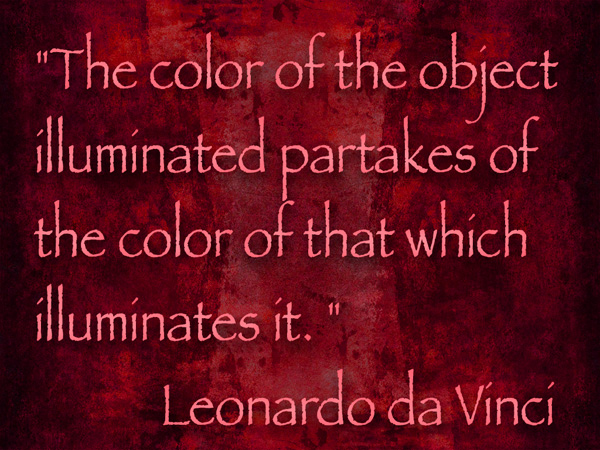
“The color of the object illuminated partakes of the color of that which illuminates it.” Leonardo DaVinci
In spite of the stilted language the information is important to consider while we shoot. What color are the surroundings of our subject? If photographing in an area of lawn or surrounded by trees the prevailing color is green. The sun lights the green and according to Leo’s observation the reflection of the green is what lights our subject. I don’t now about you but every time I see a green subject, unless it was Kermit the Frog, it’s a problem because our subject looks to be ill. “But, I love the background and the park!” I know, I know the location is wonderful. So what should be done for pleasing skin tones? We can overpower the light that is reflected from the green by adding flash on our subject. Clean light equals clean skin tones and because we direct the light with modifiers we still get the nice green color of the grass and trees – And save a lot of time and effort in post production from trying to clean up those skin tones.
Speaking of post production, I am doing a lot of art based images and Mr DaVinci’s writing has alerted me to being careful to render scenes being aware of the reflected colors to add realism to the art pieces. Check some of the work I did with images from France…
by successfulbob | commercial photography, Lumix GX7, Lumix Lounge, photography education
Learning to see light the way the camera sees it is important to getting better images. Since I have been living with my new Lumix GX7 camera lately because of it’s small size and features I have discovered something that I have been told many times in the past by superb photographers I highly respect. You gotta make images! Lots of them!
Have you ever looked at a scene and thought, Wow, that’s gorgeous! only to be disappointed by the resulting image capture? Well that’s happened to me too… Not as much anymore because I am practicing on a regular basis and not on my paid clients. Every time I see a scene now that interests me at all i make an image then see how it stacks up to how I thought it was going to render.
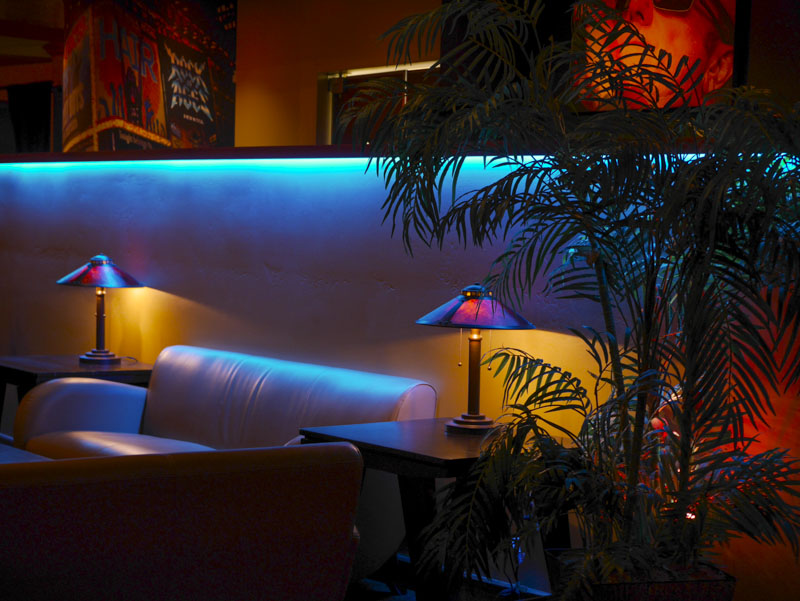 Lounge area at Sound Bites Grill Sedona, Arizona
Lounge area at Sound Bites Grill Sedona, Arizona
I was at dinner last night and saw these lights playing with the shadows. We have a very high contrast scene and just for jollies I wanted to see how it played out. The light along the top of the wall. Lighting of the art on the wall behind. The lamps. The reflections on the couches… You get the idea. I shot this as a jpeg so I didn’t have all the information available to me to do post adjustments but I still opened the photo in Adobe Camera Raw and was able to open up the shadows just a bit. I am surprised by the detail held in the highlight while still getting information in the shadows.
Tiger Woods doesn’t only come out to the golf course when he’s playing a tournament. As a matter of fact he will often head to the driving range or putting green after a round while still in the tournament to work on his game. So I guess my question to you is, “How much are you working on your game??”
Yours in photography, Bob
by successfulbob | commercial photography, fine art musician portrait, Lumix GX7, Lumix Lounge, photography, photography education
Sound Bites Grill brought in the Steph Johnson Trio to entertain last week on Sunday night. Wow! It was wonderful. Steph has a really low smoky sounding voice and plays a silky smooth jazz guitar. Rob Thorsen was on upright bass and he was making beautiful sounds that I had never heard a bass make before. On drums Fernando Gomez showed skills mastered because he started drumming before the age of ten. All in all lots of good sounds. The Steph Johnson Trio will be right at home on the ‘Sound Bites Grill Wall of Fame’. I created a single image of Steph and one for the Trio. I used the *Lumix GX7. I’ve found this camera to have a great dynamic range which is extremely helpful in capturing the variety of mixed color stage lighting.
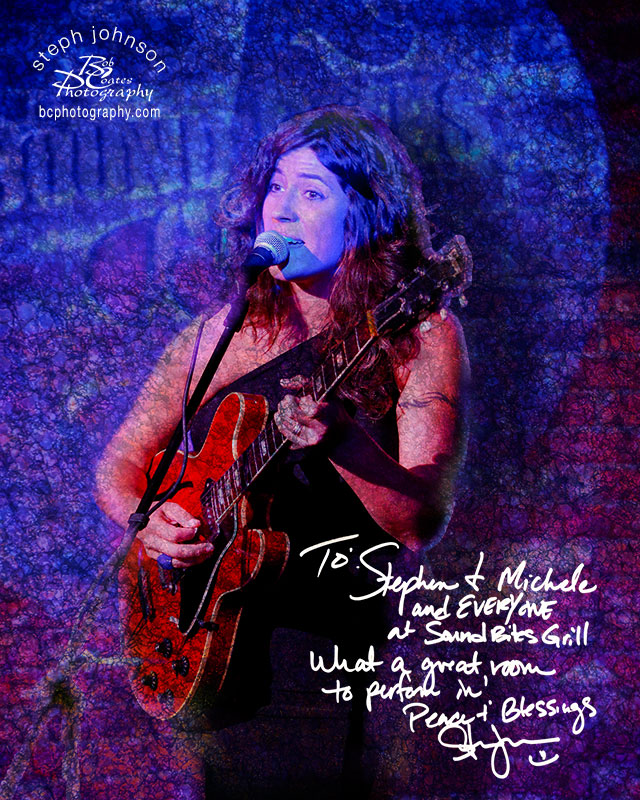 Steph Johnson live on stage at Sound Bites Grill.
Steph Johnson live on stage at Sound Bites Grill.
See below for some ideas on the techniques used to create this look.
The technique I am using is one I call ‘Photo-Synthesis’. It starts with a base image, or in this case multiple images of the band members. They are all cut out, even if they are going to stay in the same position and placed on their own layer. After the musicians have been put together into the composition texture layers are added by placing images of metal, rock, walls or grasses or – you get the idea – almost anything will give a different look and feel as the various blend modes of each layer are adjusted. The blend modes allow the layers to interact with the layers below in different mathematical ways. The old ‘if this, then that will happen’. Shuffling layers, changing blend modes, and adding masks tweak the look. Where the individuals were placed on their own layers makes it possible to add drop shadows and lighting effects to enhance the depth selectively.
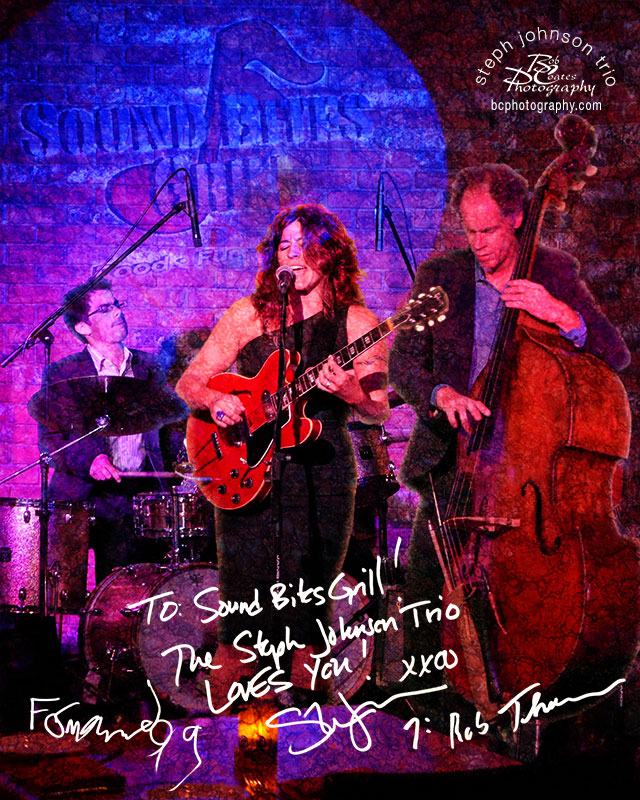 The Steph Johnson Trio at Sound Bites Grill in Sedona, Arizona by Bob Coates Photogrpahy
The Steph Johnson Trio at Sound Bites Grill in Sedona, Arizona by Bob Coates Photogrpahy
One last tip is adding the autograph messages from the band. Because it would be difficult to track down the individuals after the photographic art work is completed I have the musicians sign a blank white piece of paper with a black Sharpie marker just as if they were signing their autograph. This is scanned and brought into the final composition as a layer. The image is inverted turning black to white. Blend mode is set to screen and the signature magically blends into the image with no muss no fuss.
If you would like to learn more about how I work with Adobe Photoshop in creating this type of imagery I am available for personal coaching or if you have a photo group I can present a program. As a *Panasonic Lumix Luminary I could be sponsored for your event. Give me a shout to get details.
by successfulbob | fine art photography, photography - art quote, photography education
Providing these quotes to you every Sunday is actually becoming a gift to myself. As I search for quotes that I feel would be of interest I run across many more that give me food for thought. Even more thinking through my reactions and sharing the ideas with you makes me give pause and understand my own thinking on this process of creating art from photography.
I thank you. And, without further ado here’s this Sunday’s art quote.
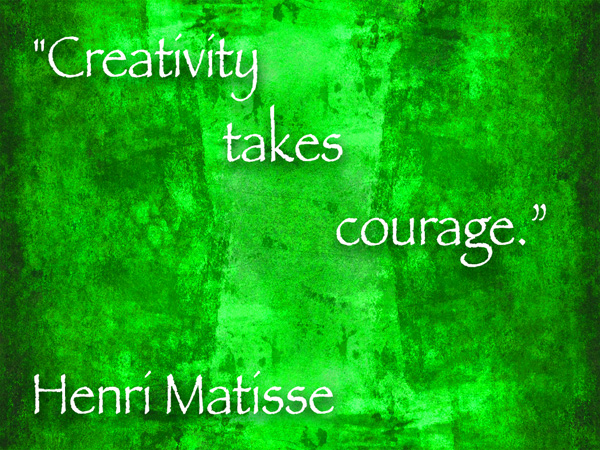 “Creativity takes courage.” Henri Matisse
“Creativity takes courage.” Henri Matisse
Three short words. Maximum impact from Matisse.
I can’t tell you how many times I have walked away from a piece of art because I ‘THOUGHT’ it may not be received well and I might get ridiculed or told that something isn’t the norm. Most of the fear is generated from within and has absolutely no basis in fact. It is important to override the self-doubt of the inner voice that holds you back. And after you have broken through the inner doubt be ready to counter any beginning negativity you ‘MAY’ hear from other. Think about the ridicule and grief the Impressionist Painters were subject to when they first began to unveil this new way of showing the world to itself. Now there entire museums around the world dedicated to the display of this art.
“Why talk about this Bob?” you might ask. “I’m a photographer not a painter.” I say, if we take this career seriously and are beyond just pushing the camera button on P or A or S and taking what our camera gives us we are creating images of artistic intent. What subject and how do they pose or are they framed in the viewfinder. What lens, angle of view. Light and shadow – take what’s there or craft it by adding or subtracting? this doesn’t even begin to think about how the set is staged. What extras do you add or take away? How about post processing? Some? A little? A lot? Adding multiple images?
I ran into a budding photographer on the trail the other day and he said he didn’t want to “cheat” by adding filters or making multiple exposures to record the scene or do extra work in post. Reminds me of myself when I first started. I said the exact same thing until I learned that the camera does not see as the eye does and in order to show the scene as the eye sees it there must be adjustments made. And for sure the camera doesn’t see the way my mind sees. All the additions and adjustments, multiple exposures and post production bring forth what my minds eye sees. And, less and less do I worry about what others may think. I may have finally found the courage that Matisse has spoken of….
 Image for CD cover of Robin Miller. (Robin likes it!)
Image for CD cover of Robin Miller. (Robin likes it!)










